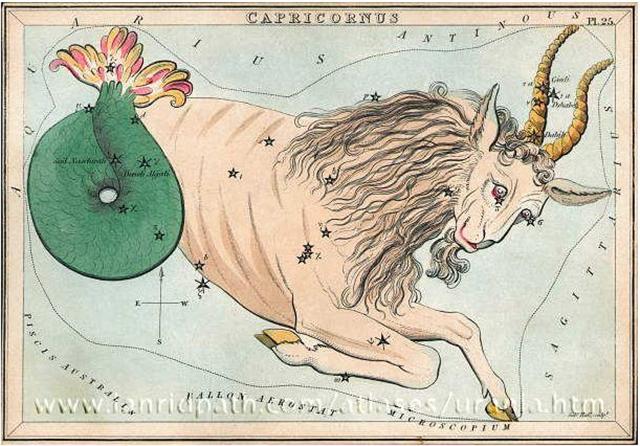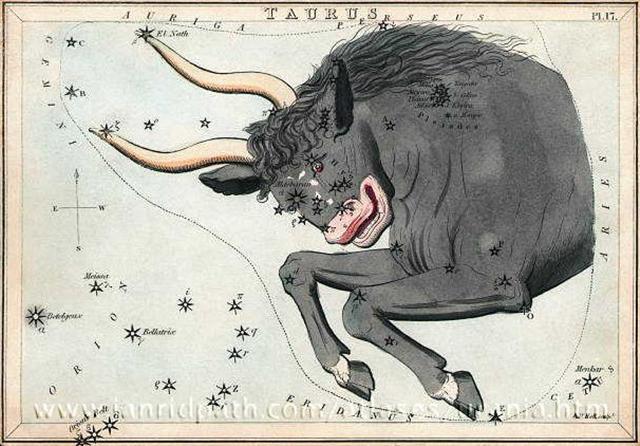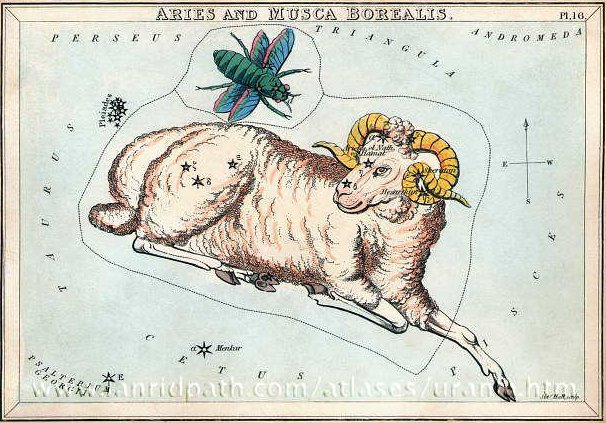2. We can no longer avoid asking the obvious question: Why is the Archer oriented with his face to the past instead of in the direction where the flying Arrow is? Possibly the reason is that the constellations once were depicted by people who read from right to left. Hevelius has his pictures with right ascension increasing towards the right and he may have adjusted the view so as to be convenient for someone accustomed to read from left to right. ... Men and birds joined forces to destroy the huge watersnake, which dragged all living creatures down to his lair. But the attackers took fright and cried off, one after the other, offering as their excuse that they could only fight on dry land. Finally, the duckler ... was brave enough to dive into the water; he inflicted a fatal wound on the monster which was at the bottom, coiled round the roots of an enormous tree. Uttering terrible cries, the men succeeded in bringing the snake out of the water, where they killed it and removed its skin. The duckler claimed the skin as the price of its victory. The Indian chiefs said ironically, 'By all means! Just take it away!' 'With pleasure', replied the duckler as it signalled to the other birds. Together they swooped down and, each one taking a piece of the skin in its beak, flew off with it. The Indians were annoyed and angry and, from then on, became the enemies of birds. The birds retired to a quiet spot in order to share the skin. They agreed that each one should keep the part that was in its own beak ... The huge watersnake could be the Milky Way. And its coloured skin, which was cut up and distributed among the birds (high up), could represent the pieces of an original Milky Way zodiac. Each separate piece was still in perfect order but the former connections between them had been irreparably broken. The watersnake ought to be in the region of the sky called 'water', and this region was probably beginning beyond Nunki (σ Sagittarii). Interestingly Allen has an illuminating note regarding Tigris, to the east of Euphrates: "The Hebrews called it [the Sagitta constellation] Hēs or Hēts; the Armenians and Persians, Tigris; and the Arabians, Al Sahm, all implying an Arrow; this last, given on the Dresden globe, being turned by Chilmead into Alsoham, by Riccioli into Schaham, and Piazzi into Sham." "... The Ancient Greek form Tigris was borrowed from Old Persian Tigrā, which was in turn borrowed from Elamite ti-ig-ra, itself from Sumerian idigna. The original Sumerian Idigna or Idigina was probably from *id (i)gina 'running water', which can be interpreted as 'the swift river', contrasted to its neighbor, the Euphrates, whose leisurely pace caused it to deposit more silt and build up a higher bed than the Tigris. The Sumerian form was borrowed into Akkadian as Idiqlat, and from there into the other Semitic languages (cf. Hebrew Hîddeqel, Syriac Deqlat, Arabic Dijla). Another name for the Tigris used in Middle Persian was Arvand Rud, literally 'swift river'. Today, however, Arvand Rud refers to the confluence of the Euphrates and Tigris rivers (known in Arabic as the Shatt al-Arab). In Kurdish, it is also known as Ava Mezin, 'the Great Water' ..." (Wikipedia) Tigris in the east runs quickly like an arrow in contrast to the slower (presumably serpentine) Euphrates in the west. Tigris acts more lively as if younger than the slow Euphrates. The fertile Mesopotamian land in between can then be compared to the cycle of life from birth to death. Possibly, therefore, the 'Sea-Goat' (Capricornus) represents Tigris in contrast to the Serpentine Bow of the Archer which could represent Euphrates. ... The 19th manzil lay in the vacant space from the upper part of the figure toward the horns of the Sea-Goat, and was known as Al Baldah, the City, or District, for this region is comparatively untenanted. It was marked by one scarcely distinguishable star, probably π, and was bounded by six others in the form of a Bow, the Arabs' Kaus, which, however, was not our Bow of Sagittarius ... There is a contrast between an arrow and a bow. One must be very straight while the other has to be curved. One remains still in the hand while the other quickly darts away. If the arrow symbolizes Sun (by way of its straight rays) then the other has to symbolize Moon. Capricornus is beginning in the 21st hour, only half a month after Sagitta.
Clearly the front part of the Sea-Goat can be compared with the front part of the Bull, 8 months earlier:
Taurus is a Sun character, looking forward, while Capricornus is looking in the other direction (like Sagittarius), withershins. The front legs of the Sea-Goat are drawn like those of the Ram, and probably this Sign indicates they both are reclining females:
|


